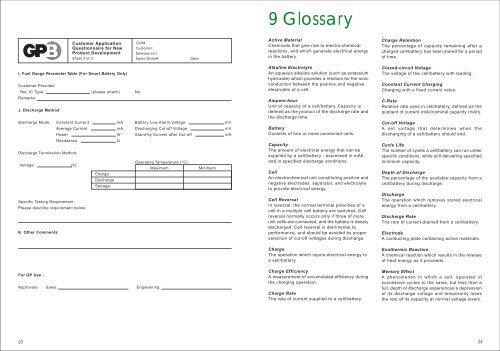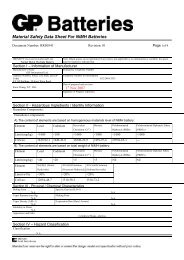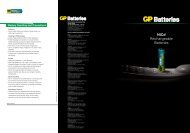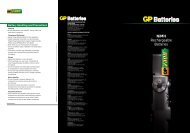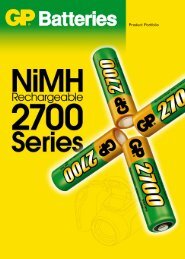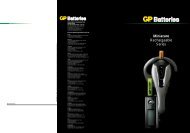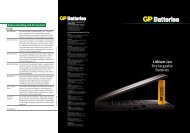Nickel Metal Hydride Technical Handbook - Gold Peak Industries
Nickel Metal Hydride Technical Handbook - Gold Peak Industries
Nickel Metal Hydride Technical Handbook - Gold Peak Industries
- No tags were found...
You also want an ePaper? Increase the reach of your titles
YUMPU automatically turns print PDFs into web optimized ePapers that Google loves.
9 GlossaryCustomer ApplicationQuestionnaire for NewProduct DevelopmentSheet 3 of 3CAP#Customer:Salesperson:Sales Order#:Date:Active MaterialChemicals that give rise to electro-chemicalreactions, and which generate electrical energyin the battery.Charge RetentionThe percentage of capacity remaining after acharged cell/battery has been stored for a periodof time.I. Fuel Gauge Parameter Table (For Smart Battery Only)Customer Provided Yes, IC Type (please attach) No.Remarks:J. Discharge MethodDischarge Mode: Constant Current mA Battery Low Alarm Voltage mV Average Current mA Discharging Cut-off Voltage mV Power W Stand-by Current after Cut-off mA ResistanceΩDischarge Termination Method: Voltage(V)Operating Temperature (°C)MaximumMinimumChargeDischargeStorageSpecific Testing Requirement:Please describe requirement below.K. Other CommentsAlkaline ElectrolyteAn aqueous alkaline solution (such as potassiumhydroxide) which provides a medium for the ionicconduction between the positive and negativeelectrodes of a cell.Ampere-hourUnit of capacity of a cell/battery. Capacity isdefined as the product of the discharge rate andthe discharge time.BatteryConsists of one or more connected cells.CapacityThe amount of electrical energy that can besupplied by a cell/battery - expressed in mAh,and in specified discharge conditions.CellAn electrochemical unit constituting positive andnegative electrodes, separator, and electrolyteto provide electrical energy.Cell ReversalIn reversal, the normal terminal polarities of acell in a multiple cell battery are switched. Cellreversal normally occurs only if three of moreunit cells are connected, and the battery is deeplydischarged. Cell reversal is detrimental toperformance, and should be avoided by properselection of cut-off voltages during discharge.Closed-circuit VoltageThe voltage of the cell/battery with loading.Constant Current ChargingCharging with a fixed current value.C-RateRelative rate used in cell/battery, defined as thequotient of current (mA)/nominal capacity (mAh).Cut-off VoltageA set voltage that determines when thedischarging of a cell/battery should end.Cycle LifeThe number of cycles a cell/battery can run underspecific conditions, while still delivering specifiedminimum capacity.Depth of DischargeThe percentage of the available capacity from acell/battery during discharge.DischargeThe operation which removes stored electricalenergy from a cell/battery.Discharge RateThe rate of current drained from a cell/battery.ElectrodeA conducting plate containing active materials.ChargeThe operation which inputs electrical energy toa cell/battery.Exothermic ReactionA chemical reaction which results in the releaseof heat energy as it proceeds.For GP Use :Approvals: Sales: Engineering:Charge EfficiencyA measurement of accumulated efficiency duringthe charging operation.Charge RateThe rate of current supplied to a cell/battery.Memory EffectA phenomenon in which a cell, operated insuccessive cycles to the same, but less than afull, depth of discharge experiences a depressionof its discharge voltage and temporarily losesthe rest of its capacity at normal voltage levels.23 24


